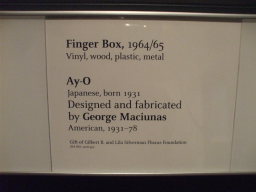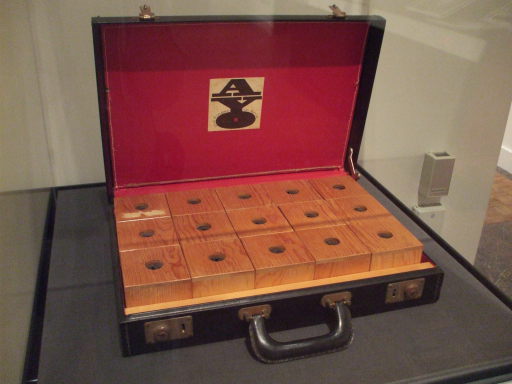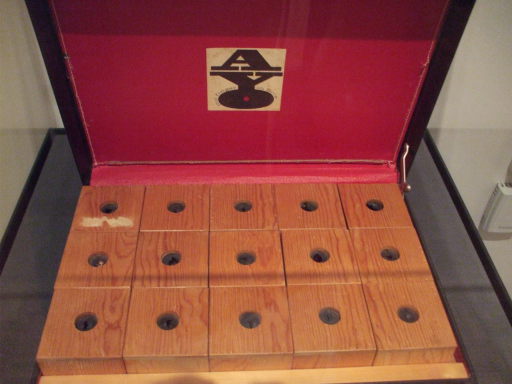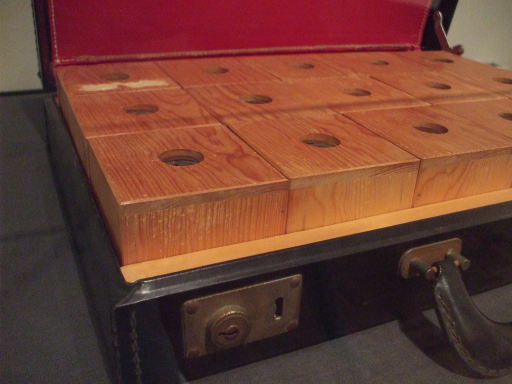
Finger Box
What Is Fingerbox?
The Finger Box is ostensibly a relatively simple device. But in fact a modern finger box is a staggeringly complex machine, with late 20th Century models comprised of many finely crafted components. These are most often distributed in sets of nine, but the poor, the disenfranchised and the mentally handicapped have all been observed amusing themselves for hours at a time with just a single unit. Finger boxing (also referred to colloquially as "fingering" and/or "boxing") is a rapidly growing trend among youths aged 13-18. All the same, finger boxing is well known throughout the former British Empire as the sport of gentlemen.
Finger boxes date back at least three centuries, when they were made by individual craftsmen for personal use. The commercial instance of the device, though certainly in a cruder and less intricate form than today's complex models, was developed by Sir Eustace Henry Trollington in 1862 in Dunbartonshire, Scotland.
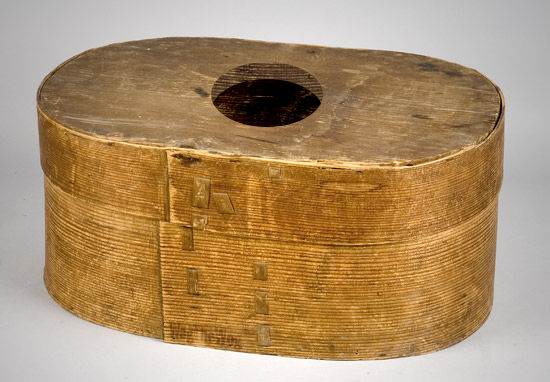
A mid-1800s finger box built by an individual craftsman from teak and veneer.
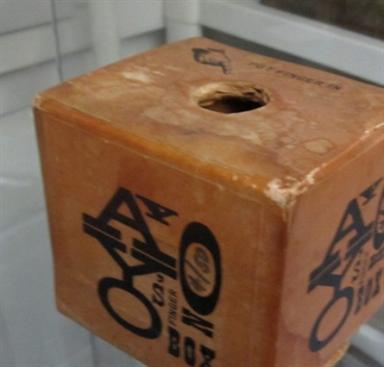
A heavily waxed finger box intended for use at sea.
Finger boxes quickly became immensely popular among British sailors, who used them during their long sea voyages. Naval models of that era can often be recognized by their heavy coating of protective wax.
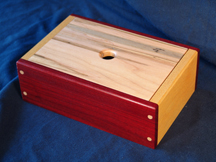
Late 1920s Japanese finger box in mahogany and blond teak.
However, the initial commercial popularity was short-lived when a group of vicious saboteurs started distributing finger boxes contaminated with old razor-blades, broken glass and carpet tacks. Panic ensued as a result of the dismemberments, lock-jaw and — in some cases — slow and inexorable deaths. This led to the inevitable banning of the devices by the UK parliament in 1901, with most of the developed world quickly following suit. The nations of East Asia were noteable exceptions to this ban.
The Japanese and Chinese craftsmen had access to a wide variety of tropical wood, leading to a great deal of innovation in the esthetic qualities of Asian finger boxes in the inter-war period. Meanwhile most of their finger boxes replicated the functionality of the 1862 Trollington design.
Here you see a Misawa craftsman's finger box in mahogany and blond teak, a classic single-hole unit using a modification of the Trollington mechanism.
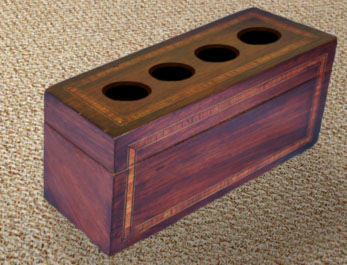
An early multi-hole design from Malaysia.
The early 1930s saw the first multi-hole designs, an innovation thought to have been developed in the Malay peninsula, perhaps in southern Thailand. Rumors quickly spread about these as-yet unseen devices. They were commercially seen for the first time a few years later in the underground markets in Hong Kong specializing in prohibited goods such as finger boxes, tonga plugs, and both raw and crystallized laforulum.
Boxes from this period are expensive and hard to come by, but they are easy to maintain. Periodic applications of boiled linseed oil are sufficient to protect the wood and the internal mechanism.
Although still illegal in Europe, the Americas and the major Oceanic nations, the finger box black market prospered after World War II. Japanese craftsmen produced them for the export market, as the near-disappearance of the geisha class had deprived them of their principal domestic market. Wealthy decadent Germans bought finger boxes in vast numbers, leading to commemorative models specifically crafted for the German market.
The British legal ban was allowed to expire, and again most nations followed. Finger box sales flourished during the 1980s.
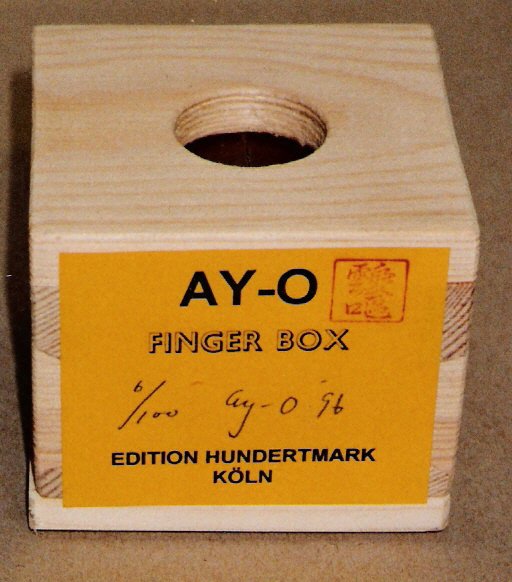
A Japanese finger box produced for the German export market.
Misguided Soviet competition with the west led to some impractical designs during the early through mid 1980s. Steel and other metals were introduced, to the abhorrance of finger box traditionalists and purists. Maintenance is significantly more involved with a steel finger box, with all the oxidation caused by the moisture drawn by skin oil. Furthermore, a 32-hole finger box as seen here would be of no practical application. Its limited production before the collapse of the Soviet Union was intended only to underscore the ideology of collectivism through programs of group boxing, activities often announced but seldom carried out except among Party elite.
However, that is not to say that Warsaw Pact finger box technology was not without its useful innovations. Here we see an East German kit for tuning, adjusting, and zeroizing finger boxes. Notice that this elaborate kit includes a full set of flanging discs as well as the less commonly seen damping rods (in a variety of diameters) and roller beams for precise torsion settings!
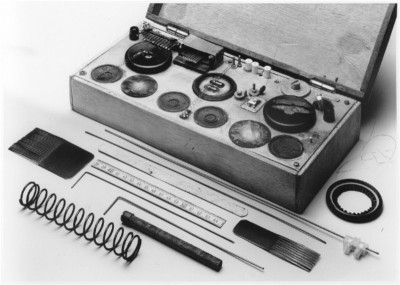
East German finger box tuning and adjustment kit.
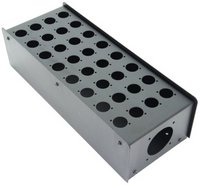
Steel 32-hole Soviet finger box with charging cover removed.
Then, the entire concept of the finger box changed in the mid 1990s with the development of the first finger box with embedded electronics, invented by an unnamed Chinese engineer.
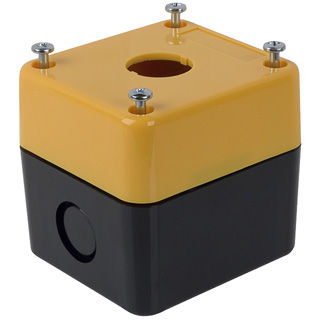
Cheap modern plastic toy marketed as a finger box.
Soon after the construction of the industrial plants in the Shenzhen area of China, the international market was flooded with low-cost injection molded devices advertised as finger boxes but lacking almost all the expected features. Aficionados refer to these as "toy boxes", and many Internet chat rooms are periodically flooded with so-called "flame wars" prompted by the naive (or sometimes malicious) reference to these as actual finger boxes.
A class action lawsuit was brought before The Hague to prohibit the use of the term "finger box" in connection with these low-cost plastic devices. However, the suit was eventually dismissed due to the lack of a legal finger box market in Europe during the time period cited as prior art.
The modern quality finger box costs around $50 per box and demand outstrips supply by ten to one, with some waiting times rumoured to be up to four years. Stainless steel units are advertised for $80 and up, promising low maintenance and simplified cleaning, but the production of these is even further backlogged than is the case with the traditional wooden units. And, while a stainless steel finger box is certainly a rare item, those owners willing to speak on the subject have reported the performance as barely adequate.
However, finger box connoisseurs often prefer the vintage designs. Some pre-World-War-II finger boxes have reportedly been sold for upwards of $5000, at least in the case of specimens with fully documented provenance tracing back to the craft ateliers of Kyōtō.
Y'know, I'm not sure about these new e-fingerboxes. Sure, they're pretty, but a 250-year-old teak fingerbox made in England, Germany or Japan will do the job just as well, and has got tons of potential for upgrading. I've got a collection of all sorts, and I must say that one of my favourites is a 170-year-old scrimshandered palm fingerbox from Rehoku which feaures part of a dendroglyph and was crafted by British sailors stuck on the island from HMS Prophetess. It's a gorgeous bit of work and is so beautiful. The overall feel is very good inside too, as it was lined with lambskin and felt. The mechanism is in tip-top condition because even though it's a wooden Heidelburg design the actual wood used is, like the case, palm and thus can be kept beautifully clean and functional with palm oil, which also brings out a lovely dark finish. It's locked with an ivory key (cut from whalebone) engraved with the intials A.E. and in a niche inside the lid is a Gold Sovereign, which I only found when examining the fingerbox just after I bought it — I was looking at the hinge and I noticed a tiny button, and click! Out it came. It's a wonderful piece of work, I had it insured for £17,000 but I think it would make several times that at auction... implying that I'd ever sell such a wonderful object, of course.
A mid-20th century set of fifteen carefully matched finger boxes can be seen by the public in Detroit at the Detroit Institute of Art.
